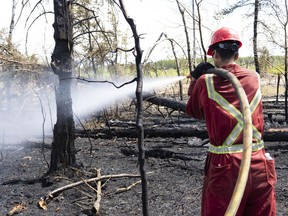Indigenous fire teams in Sask. aim for bigger role after B.C. blazes
Communities on the front lines could be new sources of leadership for fire fighting.

Article content
Brady Highway was 15 when he fought his first wildfire for roughly two weeks at his family cabin.
About 250 more fires have been added to his list since then, but when the Peter Ballantyne Cree Nation member saw a wildfire destroy the community of Lytton, B.C., he was concerned.
For him, it’s “climate change breathing down our necks,” increasing the frequency and the severity of wildfires threatening remote communities, he said.
“It’s a very big concern of all of our communities up in the northern part of the boreal (forest). But then there’s also been dwindling resources. Fire crews are in much demand.”
Highway is a project manager of wildfire strategy with the Indigenous Leadership Initiative.
Northern communities on the front lines could be new sources of leadership for firefighting.
The Prince Albert Grand Council’s wildfire team has spearheaded some of those discussions. In 2018, PAGC released its Wildfire Task Force Interim Report, calling for First Nations communities to be more involved with creating solutions as they become more exposed to wildfires.
Robin McLeod, who works with PAGC as a consultant on the file, said the province has already picked up on some of the task force’s recommendations, like expanding the size of fire crews.
“Our Indigenous knowledge is probably the leading factor in governance,” McLeod said.
“We can talk about things that we’ve experienced as First Nations people when it comes to wildfires. If there’s a fire, it’s right there, like it’s in our living room or our kitchen. It can get very personal for some people.”
PAGC has a unique relationship with the provincial government, which could be a lesson to other provinces, said Michelle Vandevord, a member of Muskoday First Nation and president of the Aboriginal Firefighters Association of Canada.
It’s rare to have First Nations crews in northern communities working on mitigation and prevention when not called on to fight a wildfire, she said.
Vandevord would like to see First Nations crews take a larger, more active role in firefighting efforts — both on the front lines and in the planning and strategy stages that typically take place in the winter.
That could even extend to including Elders who are former firefighters, she said.
“Which is a big driver of what’s coming out of B.C. right now: Let’s come to the table as government and First Nations, and work together.”
PAGC forestry program director Cliff Buettner sees another area that could use a revival after going dormant: bringing in community members in emergency situations.
There’s invaluable experience among First Nations members who’ve lived on trap lines and understand life in the bush. It should be put to use, he said.
Highway also has another memory of that first fire when he was 15. He recalls provincial crews putting their base at risk to protect a community graveyard. It’s a story worth repeating about the possibilities of collaboration, he said.
He agrees with Buettner’s comments. Highway remembers communities like Cumberland House having emergency fire crews, often composed of families who went into the bush for weeks to protect their communities.
A resurgence of the model is needed as wildfires become greater threats and sharing firefighting resources between provinces may become more of a challenge, he said.
“It’s going to be very difficult for Canada to mobilize the resources that it needs without tapping into those community areas of expertise.”
The news seems to be flying at us faster all the time. From COVID-19 updates to politics and crime and everything in between, it can be hard to keep up. With that in mind, the Saskatoon StarPhoenix has created an Afternoon Headlines newsletter that can be delivered daily to your inbox to help make sure you are up to date with the most vital news of the day. Click here to subscribe.








Postmedia is committed to maintaining a lively but civil forum for discussion. Please keep comments relevant and respectful. Comments may take up to an hour to appear on the site. You will receive an email if there is a reply to your comment, an update to a thread you follow or if a user you follow comments. Visit our Community Guidelines for more information.